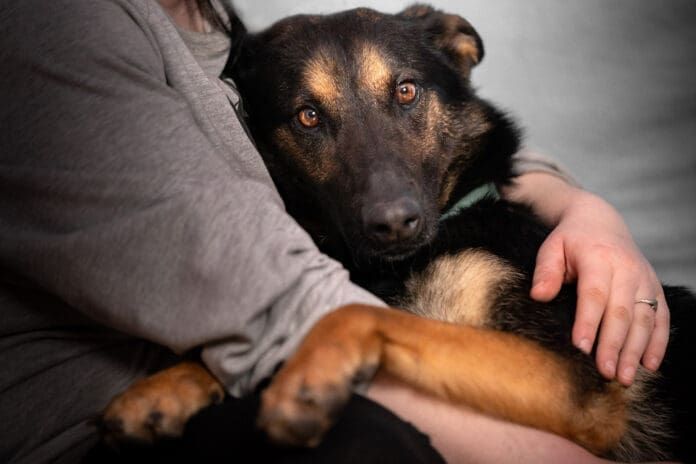At one time, strokes and mini-strokes were thought to only occur in people. When I was in veterinary college, I was taught that strokes almost never occur in our small animal patients. But with the increased use of magnetic resonance imaging (MRI) in veterinary medicine, we are finding out that strokes and mini-strokes in dogs are not impossible.
Thankfully, strokes (also known as cerebrovascular accidents, or CVAs) and mini-strokes (also known transient ischemic attacks, or TIAs) remain rare in our canine companions. CVAs and TIAs tend to happen in middle-aged to older dogs, although younger dogs with certain underlying conditions may be at increased risk. Strokes are seen more often in Greyhounds, Cavalier King Charles Spaniels, and Miniature Schnauzers.
What is a Stroke?
A stroke is an acute onset of one or more neurologic symptoms. It is caused by an interruption of blood flow to a particular section of the brain. This blood flow interruption could be partial or complete. A TIA is partial interruption of blood flow to a section of the brain. A CVA is the complete interruption of blood flow to a section of the brain.
A TIA is like the dimmer switch for a light. When you turn down the dimmer switch, you are reducing the amount of electricity reaching the light. The result is a light that still works but is not as bright as it would be if the dimmer switch was turned all the way up. A clot (also known as a thrombus) is like the dimmer switch. In a TIA, a thrombus partially occludes a blood vessel and reduces the amount of blood flowing to that section of the brain. The functions performed by that section of the brain are temporarily slowed and impaired.
Most dogs recover from a TIA within 24 hours. Dogs may continue to have TIAs in the future unless the underlying cause can be found and treated. TIAs may serve as a precursor to a CVA.
A CVA is like a clogged sink drain. When a drain is clogged, no water can get through the pipe. In a CVA, a thrombus completely occludes a blood vessel in the brain. The section of the brain served by that blood vessel quickly dies and then gradually swells. The swelling begins to subside after one to three days.
Another type of CVA is caused by a ruptured blood vessel. This is like a water main break. A break in a water main under the street results in a sudden rush of water from the pipe. The foundation under the street swells with water and causes the overlying pavement to collapse, flooding the street. A ruptured blood vessel in the brain is like that water main break. The brain tissue surrounding the ruptured blood vessel swells with blood and quickly dies.
Dogs that experience a CVA will have an acute onset of neurologic signs that gradually become worse over one to three days. After the swelling of the affected brain section subsides, most of these dogs show some improvement but may not make a complete recovery.
Causes of Strokes
Causes of strokes and mini-strokes can be divided into four categories: diseases that cause high blood pressure (also known as hypertension), diseases that cause clots or high amounts of lipids in the blood, and diseases that cause uncontrolled bleeding. The fourth category is idiopathic, meaning that the cause of a stroke cannot be found.
Hypertension can be seen in dogs that have chronic kidney disease or heart disease. Certain adrenal gland diseases—such as hyperaldosteronism and an adrenal gland tumor called a pheochromocytoma—can cause hypertension in dogs. Sometimes hypertension in dogs has no identifiable cause—this is called idiopathic hypertension. Hypertension can cause a blood vessel in the brain to rupture, resulting in a CVA.
The release of blood clots in the bloodstream can cause a TIA or a CVA. Heart disease, cancer, heartworm disease, infections of the brain, and sepsis are all diseases that can cause a thrombus to form. A condition called hyperlipidemia can cause a phenomenon similar to a thrombus. Diabetes mellitus, hypothyroidism, and hyperadrenocorticism (Cushing’s disease) are all associated with hyperlipidemia.
Spontaneous bleeding in the brain can cause a CVA. Brain tumors and head trauma can cause sudden brain hemorrhage. Immune-mediated thrombocytopenia is a condition in which there are not enough platelets to prevent spontaneous hemorrhage. Congenital clotting disorders, sepsis, and ingestion of an anti-coagulant rodenticide can also cause bleeding in the brain.
Diagnosis of a Stroke
If your veterinarian suspects that your dog may have had a stroke or a mini-stroke, she may recommend an MRI of your dog’s brain. This will allow your veterinarian to see if there is an occluded blood vessel or an area of brain hemorrhage. The cause of the stroke may also be visible on MRI, such as a brain tumor or congenital brain abnormality.
A sample of cerebrospinal fluid (CSF) may be obtained at the time your dog is undergoing an MRI. CSF can be analyzed for the presence of infection or inflammation—this can help to identify the underlying cause of a stroke.
Your veterinarian may also recommend bloodwork, including a complete blood count, chemistry panel, thyroid panel, coagulation panel, and heartworm test. Radiographs (x-rays) of your dog’s chest and abdomen may also be recommended. These tests can help identify the cause of your dog’s stroke.
Stroke Treatment
There is no specific treatment for strokes in dogs. Thrombolytic drugs (also known as clot-busting drugs) that are used in people have not been well-studied in dogs. Anecdotal reports of the use of thrombolytic drugs in dogs have identified serious side effects, including death. Thrombolytic drugs are only appropriate for strokes caused by a blood clot and may not be indicated for all dogs that have experienced a stroke.
Therapy for dogs that have experienced a stroke is aimed at maintaining proper blood flow to all parts of the brain, not just the part affected by a stroke. Therapy may include drugs to reduce pressure on and swelling within the brain, oxygen therapy, and drugs to normalize blood pressure. Identifying and treating the underlying cause of a stroke will minimize the risk of experiencing additional strokes.
Dogs that have lost functional use of their limbs may benefit from physical therapy. Physical therapy includes passive range-of-motion exercises, hydrotherapy, exercises to strengthen balance and coordination, and laser therapy. Many veterinary practices offer physical and rehabilitative services for dogs. Ask your veterinarian about what services they offer or inquire about referral to a practice that offers physical therapy.
Your dog’s ability to recover from a stroke will depend on the location and severity of the stroke, the underlying condition that caused the stroke, and your dog’s overall health. Some dogs may make a complete recovery while others may have a greatly diminished quality of life. You will need to work closely with your dog’s veterinary care team to determine the best treatment plan for you and your dog.






